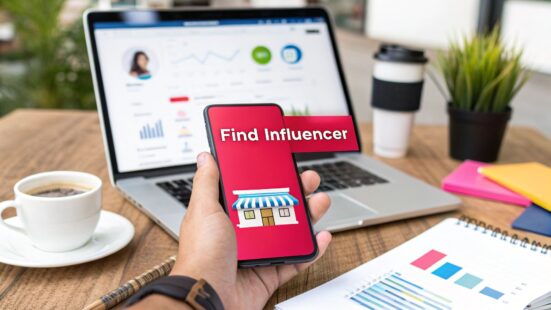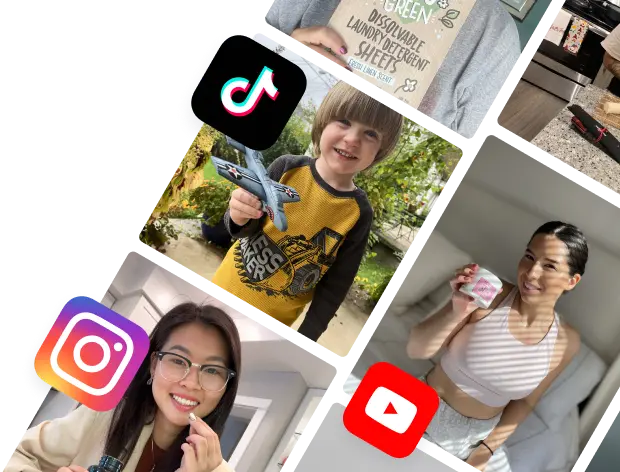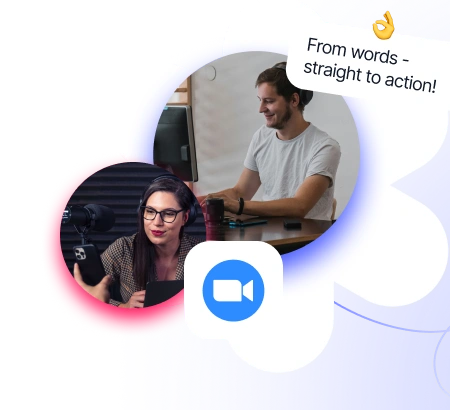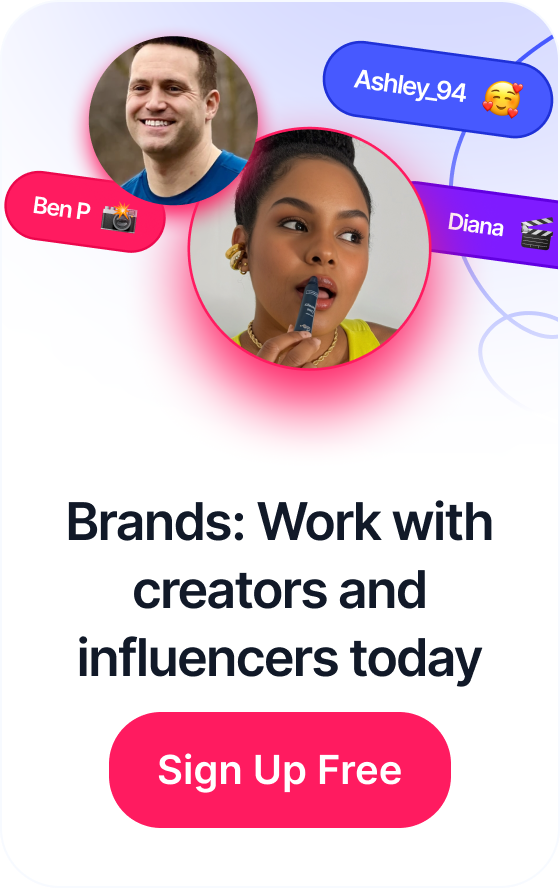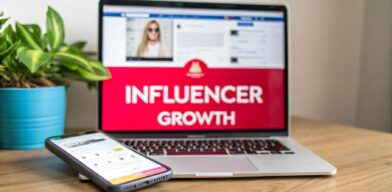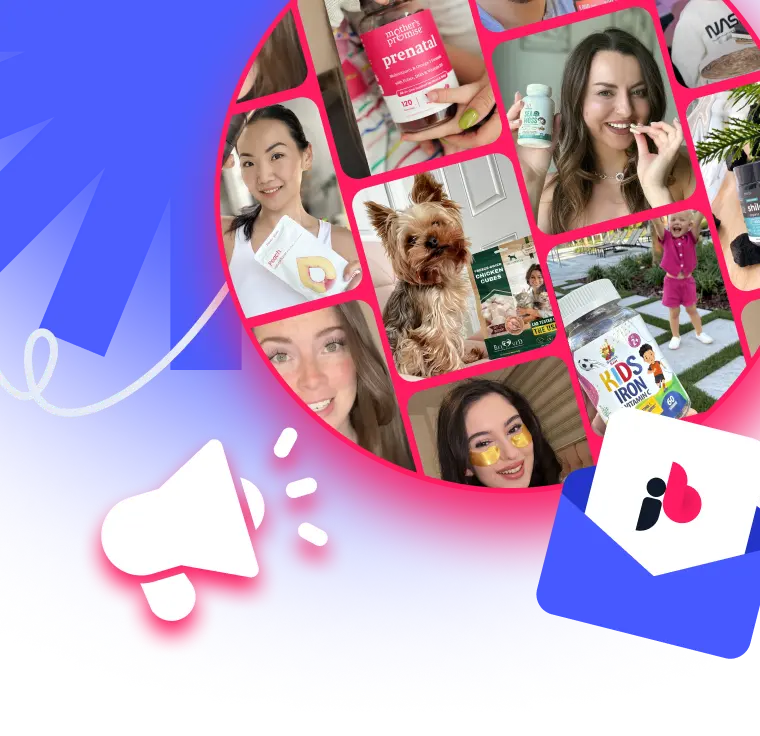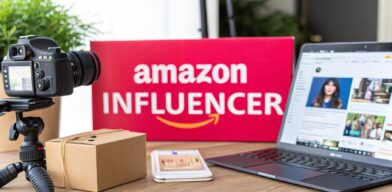 Your Guide to Amazon Influencer Programs
Your Guide to Amazon Influencer Programs
Finding Amazon influencers used to be a scavenger hunt, mixing deep dives on the platform with some serious social media detective work. You’d poke around the #FoundItOnAmazon section, watch endless Amazon Live streams, or search hashtags like #AmazonFinds on Instagram and TikTok, hoping to find creators linking back to their storefronts.
It’s a valid approach, but it’s the long way around.
Table of Contents
Why Amazon Influencers Are a Game-Changer for Brands

Let's be real: in the jungle that is the Amazon marketplace, just having a killer product isn't enough anymore. The real fight is for visibility and trust. This is exactly where smart creator partnerships change the game.
Amazon influencers give you a direct connection to shoppers who are already scrolling with their wallets out. They’re in a buying mood, and they’re looking for recommendations.
Unlike a pop-up ad that interrupts someone's day, an influencer's post feels like getting advice from a friend who’s already tried the product. This is all about social proof. Seeing a real person unbox, use, and genuinely love a product gives potential buyers the confidence to click "Add to Cart." If you're new to the concept, it's worth taking a moment for understanding social proof in marketing.
The Shift to Performance-Based Marketing
The benefits go way beyond that first sale. When an influencer sends their followers to your product page with a shoppable video or live stream, Amazon’s A9 algorithm takes notice. All that sudden traffic and conversion activity signals that your product is hot.
This can kickstart a powerful cycle, boosting your organic rankings and driving even more visibility and sales long after the campaign ends. It’s a massive shift from just paying for ad clicks to investing in authentic marketing that delivers a clear, measurable return.
The global influencer marketing industry is on track to hit $32.55 billion in 2025. That’s a huge leap from $24 billion in 2024, showing a massive trend of brands funneling their budgets into creator partnerships that actually work.
This explosive growth is happening for a reason: creator-led commerce simply performs better. Since 2014, the influencer economy has maintained a compound annual growth rate of over 33%. For Amazon sellers, this isn't just a passing trend—it's a signal that finding the right influencer is now a core strategy for growing your business.
Key Benefits of Amazon Influencer Collaborations
Working with the right creators does more than just spike your sales chart. It helps you build a more durable, trusted brand on the biggest e-commerce platform in the world.
Here’s what you stand to gain:
- Enhanced Credibility: Influencers bring their built-in authenticity to your brand, cutting through the noise and skepticism that surrounds traditional advertising.
- Increased Traffic and Sales: Their followers are already engaged and ready to shop, sending high-intent traffic straight to your product listings.
- Improved Organic Rankings: The surge in traffic and sales from a successful influencer campaign can give your product a serious boost in Amazon's search results.
Finding Influencers Directly Within Amazon

While Instagram and TikTok are goldmines for creators, you can actually find high-impact Amazon influencers without ever leaving the platform. Amazon has quietly built out an entire ecosystem to feature creator content, making it a surprisingly effective tool for prospecting—if you know where to look.
The trick is to start thinking like a shopper. Instead of searching for "influencers," search for your product category or your top-selling competitor's products. This simple shift puts you right in the path of creators who are already making content and, more importantly, driving sales in your specific niche.
Explore Amazon Inspire and Shoppable Content
Amazon's answer to short-form video is Amazon Inspire, and it’s a fantastic starting point. Think of it as a shoppable feed, like TikTok or Instagram Reels, but every piece of content is directly linked to an Amazon product.
Just open the Amazon app and navigate to the Inspire feed. You can scroll endlessly, but the real power comes from searching. Type in keywords related to your products, like "skincare routine," "camping gear," or "toddler toys," to find creators already active in your space.
When a video or photo catches your eye:
- Tap on the creator's profile. This will almost always take you straight to their Amazon storefront.
- Analyze their content. Is the lighting good? Is their presentation engaging and professional? You're looking for quality.
- Check for authenticity. Does it feel like a genuine recommendation or just another forced ad read? Authenticity is what sells.
This method helps you find creators who are not only active on Amazon but are also skilled at producing the exact type of content that converts on the platform.
Dive Into Influencer Storefronts
An Amazon Influencer Storefront is a creator's curated page where they organize their favorite products into lists. Think of it as their personal, shoppable portfolio. Finding these is a direct way to vet potential partners; a well-organized, niche-specific storefront is a sign of a serious influencer.
One of the easiest ways to discover these is by browsing the #FoundItOnAmazon section. Amazon only highlights a handful of categories here, but it's a great place to start for popular niches like home decor, fashion, and electronics.
Pro Tip: Once you land on a promising influencer's storefront, hunt for links to their social media profiles. Many creators will link their Instagram, TikTok, or YouTube in their storefront bio. This lets you cross-reference their Amazon activity with their broader social presence and get a better feel for their engagement.
Monitor Amazon Live Streams
Amazon Live is the platform’s answer to QVC-style livestreaming, where influencers demonstrate and discuss products in real time. Tuning into live streams in your category is one of the best ways to see creators in action.
You can instantly gauge their on-camera presence, see how they interact with their audience in the chat, and evaluate their ability to answer product questions persuasively. It's a live audition, and you get a front-row seat.
By actively monitoring these three areas—Inspire, Storefronts, and Live—you turn Amazon itself into your own private discovery tool. You’ll uncover creators who are already vetted by Amazon, understand the platform's nuances, and have a proven track record of creating content that actually moves the needle.
Discovering Amazon Influencers on Social Media
While Amazon’s own platform is a great starting point, you can't stop there. The reality is that the most powerful creators aren’t just waiting for shoppers to find them on Amazon; they’re actively building communities and driving traffic from other platforms.
Think about it: Instagram, TikTok, and YouTube are where these influencers have mastered the art of grabbing attention and turning their recommendations into actual sales. The trick is to find the creators who are already skilled at sending their followers over to Amazon.
This takes a bit of digital detective work, but it’s worth it. When you find these influencers, you’re not just guessing if they can sell—you’re finding creators with a proven track record of converting their audience. You're looking for more than a big follower count; you need someone who has already made Amazon a core part of their content strategy. Their followers are already warmed up and ready to shop, which makes them incredibly valuable partners.
Leveraging Hashtags on Instagram and TikTok
The most straightforward way to kick off your search on visual-first platforms like Instagram and TikTok is to dive into hashtags. Creators in the Amazon Influencer Program often use specific, popular tags to make sure their content gets discovered. This is your back door to finding top talent.
Start by searching for a few relevant hashtags. Don't just stick to one—play around with a mix of broad and niche tags to see who pops up.
A few goldmines to start with include:
#AmazonFinds#FoundItOnAmazon#AmazonMustHaves#AmazonDeals#TikTokMadeMeBuyIt
Once you search a hashtag, start scrolling through the top-performing posts and Reels. Pay attention to creators who are putting out high-quality content that matches your brand’s vibe. When you spot someone promising, head over to their profile and look for the link in their bio. This is where the magic happens—you’re looking for a direct link to their Amazon Storefront.
A creator who links directly to their Amazon Storefront is sending a massive signal. It tells you they are an active, monetizing member of the Amazon Influencer Program. This is a huge qualifying factor, separating the casual posters from the serious partners who know how to drive sales.
Uncovering Influencers on YouTube
YouTube is another fantastic hunting ground, especially if your product benefits from a detailed review, a how-to tutorial, or an unboxing video. Put yourself in your customer’s shoes: if someone is searching for a “robot vacuum review,” they’re probably deep into the buying cycle and close to making a decision.
To find influencers here, use search terms your ideal customer would use, like "best coffee makers under $100" or "unboxing the newest gaming keyboard." When you find relevant videos, immediately check the video descriptions. Influencers almost always drop affiliate links to the products they’re showing off, and many of those links will take you right to an Amazon product page.
This infographic breaks down a simple workflow for vetting your candidates.

Following this process helps you methodically filter a broad list of potential influencers down to a curated shortlist of top-tier creators who are perfectly aligned with your brand’s goals.
Using Platforms to Scale Your Influencer Search

Manually digging through Amazon and social media is a perfectly fine way to get started. You'll definitely find some gems. But let's be real—that approach has a ceiling.
When you’re ready to graduate from finding a handful of influencers to building a scalable, data-backed program, it’s time to bring in the big guns: dedicated influencer marketing platforms.
These tools were literally built to solve the biggest headaches of the search process—time, data, and organization. Instead of losing hours scrolling through hashtags and manually vetting profiles, you can tap into a centralized dashboard of pre-vetted creators who are actually looking for brand partnerships. This is the difference between aimless prospecting and strategic matchmaking.
The Power of Advanced Filtering
The real magic of a platform like JoinBrands is in its filtering capabilities. Seriously. You can instantly drill down into a huge database of creators using specific, targeted criteria that would be impossible to apply by hand.
Think about it. Let's say you need an influencer who checks all these boxes:
- Lives in the United States
- Specializes in eco-friendly baby products
- Has an engagement rate above 3% on Instagram
- Has a verified Amazon Storefront
Finding this person the old-fashioned way could take days of mind-numbing work. A proper platform can spit out a list of qualified candidates in minutes, complete with portfolios and performance data. That kind of efficiency is how you scale your efforts without having to scale your team.
Platforms transform the search from a guessing game into a precise, data-backed process. You can identify ideal partners based on concrete metrics, not just a gut feeling about their content quality. This data-driven approach is essential for predicting campaign success and maximizing your return on investment.
If you really want to pour gasoline on your discovery efforts, applying principles of how to automate lead generation can be a game-changer. The same ideas about building an automated pipeline for sales leads work perfectly for creating a steady stream of creator partnerships.
Data-Driven Matchmaking and ROI Tracking
Finding the right Amazon influencer in 2025 is all about using tools that drive conversions. We're seeing brands boost conversion rates by up to 27% just by using influencer-curated content instead of their standard product listings.
This isn't an accident. Modern platforms use smart algorithms for niche matchmaking, pairing your brand with creators whose audiences are a perfect fit for what you sell.
But it goes way beyond just finding people. These platforms provide end-to-end campaign management. You can chat with influencers, ship products, review and approve content, and handle payments—all in one place.
Most importantly, they give you the analytics to connect influencer activity directly to sales. This gives you a crystal-clear picture of your ROI, proving the value of your program and telling you exactly where to invest your budget next.
Comparison of Influencer Discovery Methods
Choosing how to find your influencers really comes down to your resources and goals. A quick manual search might work for a one-off campaign, but a platform is built for sustained growth. Here's a look at how the two approaches stack up.
| Feature | Manual Search (Amazon & Social Media) | Influencer Platform (e.g., JoinBrands) |
|---|---|---|
| Speed & Efficiency | Very slow and labor-intensive; requires hours of manual vetting. | Extremely fast; find pre-vetted influencers in minutes with advanced filters. |
| Scalability | Difficult to scale; managing more than a few influencers is a logistical nightmare. | Highly scalable; manage hundreds of campaigns and creators from one dashboard. |
| Data & Analytics | Limited to publicly available data; ROI tracking is manual and often inaccurate. | Rich data profiles, performance metrics, and direct ROI tracking are built-in. |
| Creator Vetting | Relies on gut feeling and manual checks; high risk of partnering with fakes. | Influencers are pre-vetted for authenticity, audience quality, and professionalism. |
| Campaign Management | Disorganized; communication happens across email, DMs, and spreadsheets. | Centralized hub for communication, content approval, payments, and reporting. |
| Cost | "Free" in terms of platform fees, but very expensive in terms of time and labor. | Typically a subscription-based model; offers significant ROI through efficiency. |
Ultimately, while manual searching costs nothing upfront, the hidden costs in time and missed opportunities are huge. A platform is an investment in efficiency, data, and predictable results, which is essential for any brand serious about making influencer marketing a core part of their strategy.
Finding a potential influencer is the easy part. Where the real work begins—and where most brands drop the ball—is in the vetting and outreach process. Just because a creator has a polished Amazon Storefront and a decent following doesn't mean they're the right person to champion your product.
You've got to dig deeper. It’s about making sure their audience is your audience and that their past work has the quality and feel you're looking for. This is the step that separates the high-ROI campaigns from the ones that just fizzle out. You're looking for a genuine brand advocate, not just a temporary billboard.
Look Beyond the Follower Count
Vanity metrics like follower counts can be seriously misleading. A massive audience is worthless if it’s packed with bots or people who couldn’t care less about what you sell. The first real test is to get a feel for their audience and engagement.
Take some time and actually scroll through the comments on their recent posts, both on Amazon and their other social channels. Are people having real conversations, or is it just a wall of fire emojis and "Great post!"? Genuine engagement is a dialogue.
Here are a few things I always check:
- Audience Demographics: Does their audience look like your target customer? A creator who focuses on budget-friendly dorm room decor probably isn't the right fit for a luxury kitchenware brand, no matter how many followers they have.
- Engagement Rate: Do a quick calculation. Add up the likes and comments on a few recent posts, divide by their total followers, and multiply by 100. An engagement rate of 1-3% is a pretty solid benchmark, but it definitely varies by niche.
- Comment Quality: This is a big one. Look for specific questions about the products they feature. Comments like "How does it feel in your hand?" or "Is it easy to clean?" are gold. They signal an audience with high purchase intent.
Crafting Outreach That Actually Gets a Response
Let's be real: successful influencers get bombarded with partnership requests every single day. If you send a generic, copy-pasted template, it’s going straight to the trash folder. You absolutely have to personalize your outreach.
Start by mentioning a specific piece of their content you genuinely liked. It shows you've done your homework. "I loved your recent video on that coffee maker" is infinitely better than "I like your content." It immediately proves you're not just another brand spamming their inbox.
Key Takeaway: Your first message isn't about closing a deal. It's about starting a conversation. Be a real person, be clear about the value you offer them, and make it incredibly easy for them to say, "Tell me more."
This approach builds immediate rapport and shows you respect their craft, which positions you as a true partner, not just a company looking for a transaction.
Defining a Mutually Beneficial Partnership
A solid partnership is a two-way street. Your pitch needs to clearly explain what's in it for the influencer. Yes, that means compensation, but it also means showing how your product is a natural fit for their content and a win for their audience.
And the financial incentive is nothing to sneeze at. When done right, influencer marketing on Amazon can bring in an average of $5.78 for every dollar spent—that blows most traditional online ads out of the water. This incredible ROI comes down to trust. When an influencer recommends a product, their followers listen. In fact, about 59% of users report buying something after seeing an influencer use it. You can learn more about how Amazon influencer commissions work and why they're so effective.
When you're ready to talk details, be upfront about everything:
- Compensation: Are you offering a flat fee, a commission-based structure, or a hybrid model? Lay it all out.
- Product: This is a given, but confirm you'll be providing the product free of charge.
- Creative Freedom: Give them the key messaging points but let them run with the creative. Their audience follows them for their voice, not a corporate script.
- Expectations: Clearly define the deliverables. How many posts, videos, or Stories are you expecting? Get it in writing.
By being diligent and focusing on building a real relationship, you can turn a simple influencer collaboration into a powerful, long-term asset for your brand.
Still Have Questions About Finding Amazon Influencers?
If you’re just diving into the world of Amazon influencers, it’s natural to have a few questions. Actually, it's totally normal to have a ton of questions. Brands often get stuck on the same things, from how much this all costs to what they should expect.
Let's clear up some of that confusion so you can build a killer strategy from day one.
How Much Do Amazon Influencers Cost?
This is the big one, right? The good news is, it's probably not as much as you think.
Unlike a traditional ad campaign where you pay a hefty fee upfront, many Amazon influencer collaborations are built on a commission-only model. They earn their money through the official Amazon Associates program, getting a slice of the sales they drive to your product page.
What Are Typical Commission Rates?
Amazon actually sets the baseline commission rates, and they can be anywhere from 1% to 20%, depending on what you sell. A high-end beauty product, for instance, is going to have a much juicier commission than a budget-friendly electronic gadget.
Some brands sweeten the pot by adding a small flat fee or just sending free products, especially when they're working with creators who have a super-engaged audience.
This performance-based setup is a huge win for brands. You’re paying for actual, tangible results—not just the possibility of getting seen. It puts you and the influencer on the same team, working toward the same goal. That's a real partnership.
Don't just assume every influencer wants a massive upfront payment. Many fantastic micro-influencers are thrilled to work for commissions and free products, especially if your brand is a perfect match for their followers.
How Do I Actually Measure ROI?
This is where the Amazon ecosystem really shines. Measuring your return on investment is surprisingly straightforward.
When an influencer shares their unique affiliate link, Amazon tracks every single click and sale that comes from it. This gives you hard data on exactly how much revenue each creator is bringing in. No guesswork involved.
But don't stop at direct sales. You should also keep an eye on the ripple effects:
- Better Organic Rank: A successful influencer campaign boosts your traffic and sales velocity. This tells Amazon's A9 algorithm that your product is hot, which can push you higher up in search results.
- Social Media Buzz: Are people talking about your brand more? Track those mentions to see how the conversation is growing beyond just the influencer’s post.
- Awesome User-Generated Content: That video the influencer made? With their permission, you can repurpose it for your own social media channels or even add it to your product listing as powerful social proof.
A classic mistake is getting hung up on follower count. A creator with 10,000 die-hard fans in your specific niche will almost always deliver better results than someone with 100,000 generic followers. Always, always prioritize audience alignment over raw numbers. It’s the only way to make sure your message hits home and your campaign turns a profit.
Ready to stop scrolling and start connecting? JoinBrands makes it easy to find and manage vetted Amazon influencers who are ready to drive sales for your brand. Stop guessing and start growing. Discover your perfect creator match on JoinBrands today!
